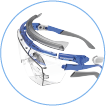
- ELECTRIC FAN TYPE PARTICLE GENERATION CONTROL
- This is Japan's only ELECTRIC FAN TYPE PARTICLE GENERATION CONTROL developed by our company to prevent dust from people from being brought into the clean room.
This is Japan's only ELECTRIC FAN TYPE PARTICLE GENERATION CONTROL developed by our company to prevent dust from people from being brought into the clean room.
A suction-type electric fan is used to filter the air in the hood and exhaust clean air downward with minimal effect on the airflow.
The number one source of dust in a clean room is humans themselves.
The LS-780C supports "human" dust generation management in clean room operation management to prevent foreign substances such as small dust and particles attached to workers themselves that are invisible to the human eye from entering the manufacturing site.
Tips on choosing ELECTRIC FAN TYPE PARTICLE GENERATION CONTROL
- Points for selection
- Use in conjunction with appropriate measures such as clean wear and air showers.
- Target works
- Nanotechnology fields such as semiconductor factories, pharmaceutical and medical device manufacturing,
hospitals, food, plant factories, cosmetics manufacturing,
device manufacturing such as digital home appliances and electronics,
various materials and their processing such as films and packaging, space field, and life sciences.
Science, bioscience fields, and other sites that require a high degree of cleanliness.
- Application
- Working in a clean room
Based on our core technology of controlling light, which we have been accumulating for over 100 years since our foundation, we have been developing industrial safety eyewear, including laser safety glasses, and various types of protective equipment.
Also, using our filter technology built up over 30 years, we have been pioneering the industry by developing dust masks and powered air-purifying respirators and continue to present new products to the market.
Moving forward, it is Yamamoto Kogaku's hope to support not only the bodily safety of workers but all aspects of people's lifestyles for safer, more comfortable living environments.









